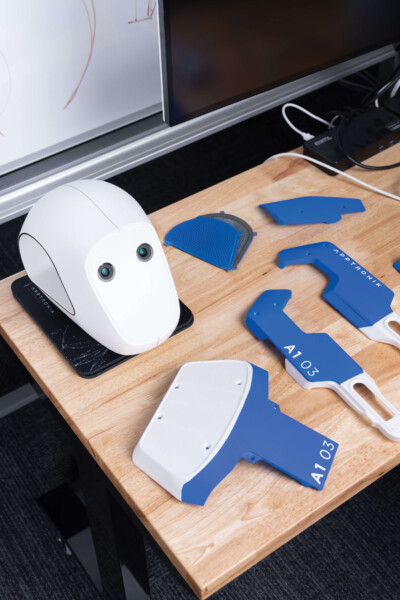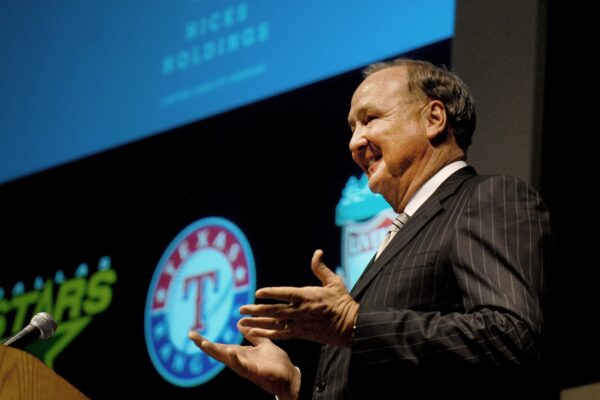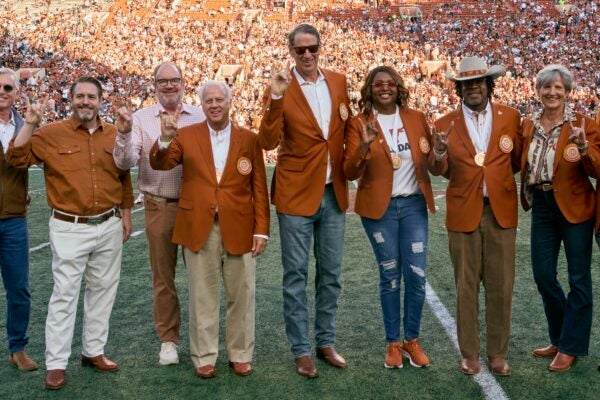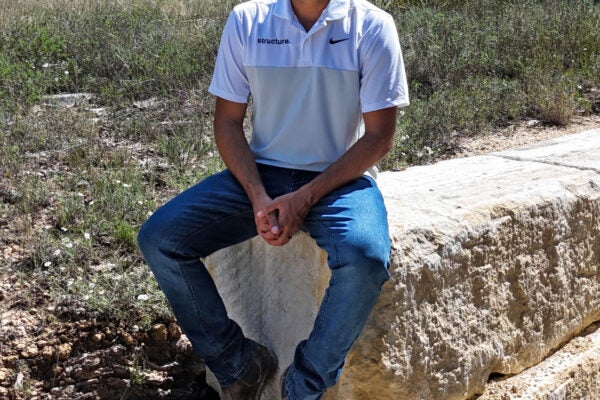Apptronik Co-Founder Jeff Cardenas, BBA ’08, MSTC ’13, is Building Humanoid Robots, Powered by Artifical Intelligence
by Omar L. Gallaga | Photographs by Phil Kline
In the warehouse-size headquarters of Apptronik in northwest Austin, the robots have not taken over, but they are everywhere you look. The company is developing “humanoid” robots to do tasks that humans do in a workplace such as sorting items, lifting heavy boxes and moving them to different locations. One day, you might find Apptronik’s robots in your home, doing the dishes or cleaning your house. Or you might find them out in public, helping people with package deliveries or cooking our food in a local restaurant.

But this isn’t “Westworld,” the HBO series where the robots have skin and aspire to fall in love. They are worker robots with arms and legs and sensors that look like eyes on their human-like skulls. But the way they learn about and adapt to their environments, then choose their actions and how to do them, is driven by artificial intelligence software.
Apptronik’s robots are taking shape in various labs across the building, mounted on chairs or hanging from cabling. They have rounded skulls, blank eyes, and exposed rotors and gears. They don’t look like Terminators; they look like sleeker, white-plastic versions of C-3PO from “Star Wars.” And they don’t walk around on their own, at least not yet, but employees at some of Apptronik’s corporate customers might start working alongside them as early as this year.
A pair of these robots lounge on a couch in the middle of the building, wearing T-shirts and baseball caps; a sign on the immobile bots reads, “In a meeting.”
Co-founder and CEO Jeff Cardenas, BBA ’08, MSTC ’13, has been thinking about robots and how they might integrate into our lives since he played with his favorite toys, Transformers, as a kid. He grew up inspired by Apple legend Steve Jobs, wondering if he might have missed the big PC computing wave that transformed society.
In 2016, Cardenas and his partners spun Apptronik out of the University of Texas Human Centered Robotics Laboratory, which is part of UT’s Cockrell School of Engineering.
“Entrepreneurship is about using your time to create tools that improve the way we live and work,” Cardenas says. “My lens was: What’s something that’s going to be everywhere in 10 years but that’s nowhere today?”
Cardenas is betting that humanoid robots will be as common and as indispensable to our lives as mobile phones.
Seeing the Future
His path to robotics, however, was not a straight line. Cardenas’ family is from Dallas, but as the son of an Air Force colonel, he moved around while growing up. He and his future wife, Christy Huddleston, BBA Business Honors ’08, M.S. Accounting ’09, met in fourth grade outside of San Antonio and ended up choosing Austin for their education. After graduating from UT, Cardenas tried starting a mobile-app company, but that market, he says, was already oversaturated.
He then joined the giant consulting firm Deloitte, where he spent four years getting exposed to companies developing new technology and figuring out “what kind of company I wanted to build long term.”
After Deloitte, Cardenas worked at the IC2 Institute at UT as a commercialization consultant. While he was there, he began to gather around him key figures in the development of Apptronik: He met retired Air Force Gen. Bill Welch, who would become a mentor and co-founder of Apptronik. Welch in turn introduced him to UT aerospace engineering and engineering mechanics professor Luis Sentis and postdoctoral robotics researcher Nick Paine.
Cardenas returned to McCombs to join the Master of Science in Technology Commercialization program. That’s where he learned how to take research-stage technology and turn it into a viable business. “I was like, ‘Man, this is kind of my dream. This is exactly what I was looking for.”
The one-year MSTC program focuses on entrepreneurship and launching tech products in particular. By this point, Sentis and Paine were building a robot for the DARPA Robotics Challenge funded by the U.S. Defense Advanced Research Projects Agency. That led to an innovation grant to start a company based on their work; Cardenas says he strongly felt that “This is the next big thing.”
“I started to riff (to Paine) on the vision for what I thought about the kind of company that could be created and why I thought Texas was the place to do it,” Cardenas says. “My take on humanoids was that I thought ‘This is the PC moment for robotics.’”
Making Robots Viable
In the mid-2010s, robots gained momentum as the cost of components to build them dropped and more companies started introducing prototypes. But robots introduced by companies such as Sony and Tesla didn’t do much more than dance on stage at tech conventions.

Computing systems were getting smaller and more mobile while sensors and motors were getting cheaper. Cardenas believed that instead of creating a robot that can do one thing well, such as a device on an assembly line with one task, a humanoid robot — one that looks less like a Roomba vacuum or an Alexa speaker and more like a human being — might be able to do thousands of things that humans can do. As the company was being built and Apptronik began developing different iterations of robots, artificial intelligence tech was becoming a big part of its strategy.
“AI has really enabled the ability to have robots that can do a much wider range of things. Robots can work in what we call unstructured applications, meaning highly variable and dynamic situations,” he says. For instance, in the past, a robot might be programmed to respond in specific ways to a situation such as catching a ball or preparing a meal. With AI, a robot can learn from its environment and improvise, performing tasks in ways it wasn’t specifically programmed to do. In this way, the robots are engaging in machine learning, modeling intelligent human behavior.
While AI is thought by most to exist in the form of software such as ChatGPT or other online tools to interact with, this is a case of AI moving off the phone and computer screen and into a physical form: Cardenas calls it “Embodied AI.”
A Robotic Future
Since 2016, Apptronik has been working on multiple versions of human-like robots. Two years ago, the company moved into its large headquarters and now has about 90 employees.
Some of its technology involves exoskeleton tech: robotic gear that humans can wear to do things like lift heavy parcels. But much of Apptronik’s focus has been on Apollo, a 5-foot-8-inch, 160-pound humanoid robot unveiled last year that evolved from the company’s partnership with NASA.
Apollo, in its current iteration, is designed to do warehouse work such as finding a specific box, picking it up and taking it to its next destination. That sounds easy for a human, but it involves a complicated set of physical movements that must account for all the potential moving objects around Apollo (including people) that must safely be navigated.
But moving boxes is just the first step for a humanoid robot. NASA and Apptronik’s plans are more ambitious. On Earth and outside of warehouses, robots such as Apollo could be software-updated to do things such as deliver medicines or perform cleaning tasks in assisted-care facilities.
In space, where Cardenas hopes Apollo will someday go, a robot could take on dangerous tasks that would typically require a human such as exploring caves and tunnels on the moon and on Mars. NASA has said that general-purpose robots with modular parts and software that can adapt to a variety of tasks would be ideal to work alongside humans in space. Such robots could make space travel and colonization safer for astronauts and allow their human co-workers to focus on science and exploration.
In addition to NASA, Apptronik has announced a partnership with a Texas manufacturer, Terex Corp., but has been tight-lipped about other companies that will be using its robots. Cardenas says Apptronik will be announcing sales to large retailers, logistics players, and manufacturers this year.
For now, Apptronik’s flagship robot Apollo is helping to alleviate labor shortages by working in warehouses and manufacturing. But Cardenas says, as they evolve, AI-driven robots may help elderly people live longer in their homes and give the rest of us more time to pursue our passions or be with family.
His own passions include being outdoors and spending time with his wife and his 7-year-old son, whose development has helped him better understand the immense complexity of humans as they grow. “It’s pretty much robots and family these days,” Cardenas says.
Cardenas has heard the concerns about robots; people worry they’ll become too powerful and that, as with AI, humans might be sealing their own doom by giving robots too much control. Cardenas says it’s something his staff discusses constantly. He says he’d rather work to keep the technology on track ethically, and make sure it’s used for good, than to sit on the sidelines as it inevitably moves forward.
His time at UT and at McCombs, Cardenas says, helped guide the future of Apptronik. “We always say ‘What starts here changes the world.’ That really planted a seed in our brains, and we try to carry that banner forward.
“We use everything we’ve learned to change the world.”
About this Post
Share:


